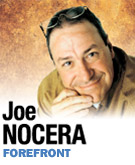Subscriber Benefit
As a subscriber you can listen to articles at work, in the car, or while you work out. Subscribe Now
 The president of the American Bankers Association was railing against excessive regulation in a speech at the Waldorf Astoria. The banking reform bill, he complained, “would destroy a substantial part of our bond-distributing machinery.” He added, “Can anyone expect that a step of this kind will improve the quality of our long-term investments?”
The president of the American Bankers Association was railing against excessive regulation in a speech at the Waldorf Astoria. The banking reform bill, he complained, “would destroy a substantial part of our bond-distributing machinery.” He added, “Can anyone expect that a step of this kind will improve the quality of our long-term investments?”
Modern echoes, for sure. But I read about the speech in a Jan. 27, 1933, article culled from the wonderful archives of The American Banker, the bankers’ bible now celebrating its 175th birthday. The speaker, one Francis H. Sisson, was complaining about an early version of the Glass-Steagall Act, the most famous of all Depression-era bank laws, and the one that, in retrospect, probably did the most good.
From my vantage point here in 2011, Glass-Steagall seems miraculous. It was amazingly radical, not just for its time, but for any time; it didn’t so much reform banking as upend it. Most notably, it ordered banks to get out of the securities business. As Sisson complained: “The effect of the proposed banking reform is to renounce investment banking rather than regulate it.”
Because investment banking was then the chief activity of the big banks, this was a very big deal.
Glass-Steagall also created the Federal Deposit Insurance Corp., which insured customer deposits for the first time, and outlawed branch banking by national bank. It is impossible to imagine anything like it passing today; the modern reform bill, Dodd-Frank, is not even comparable.
I’d long wondered how Sen. Carter Glass, the powerful Virginia Democrat, and his House counterpart, the Alabama congressman Henry Steagall, managed to get it passed. What were the politics like? What did they fight over? Why didn’t people like Sisson have better luck pushing back against it, the way bank lobbyists do today?
American Banker archives show that all the horse-trading over the bill’s provision was done by Democrats. The Republicans, having been badly defeated in the 1932 election, had no ability to block it or even amend it.
The second thing I realized was that, the Sisson speech notwithstanding, there was surprisingly little controversy over what we now think of as the law’s primary achievement: splitting commercial and investment banking. The fights were all over issues that seem inconsequential by today’s lights. It’s as if the notion of breaking the banking business into two was always a foregone conclusion.
And, for the most part, it was. Partly, this was because, unlike today, bank failures in the 1930s were often ruinous to customers. So reform was more pressing. But it was also because, for the entire time the legislation was under consideration, the Pecora hearings were going on—in which Ferdinand Pecora, the flamboyant chief counsel of the Senate Banking Committee, dragged one well-known banker after another before the committee and grilled them mercilessly, exposing how they had abused their investment banking roles, sometimes to the point of criminality.
Those hearings infuriated the country and made it unthinkable that banks would continue to be allowed to sell securities. In fact, some banks, seeing which way the wind was blowing, applauded: “The spirit of speculation should be eradicated from the management of commercial banks,” declared Winthrop Aldrich, the chairman of Chase National Bank, according to Michael Perino, Pecora’s biographer.
Ironically, Glass loathed the Pecora hearings, deriding them as “a circus, and the only thing lacking now are peanuts and colored lemonade.” But the hearings made his bill—which had been filibustered by Huey Long just 18 months earlier—not just possible but inevitable.
How inevitable? Charles Geisst, a finance professor at Manhattan College and an expert on the law, says that the House and Senate didn’t even bother with a roll-call vote for final passage. This seminal piece of legislation flew through on a voice vote.
On Friday, June 16, 1933, when Roosevelt signed it into law, The American Banker gave the news all of three paragraphs. There was nothing left to say.•
__________
Nocera is a New York Times columnist. Send comments on this column to [email protected].
Please enable JavaScript to view this content.
